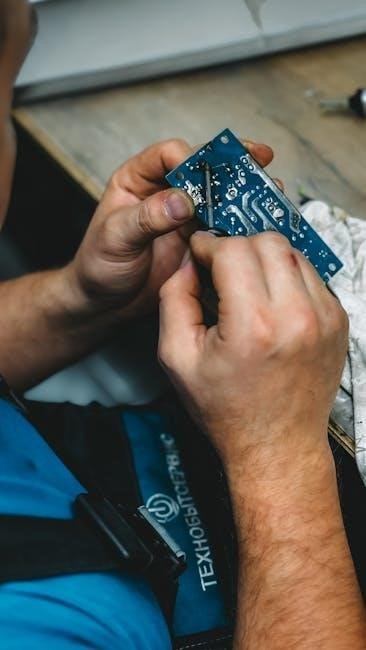The Toyota Sienna is a top choice for families, offering reliability and safety. Regular maintenance is crucial for optimal performance and longevity. This guide provides essential tips and schedules for 2023-2024 models.
Importance of Regular Maintenance for Toyota Sienna
Regular maintenance is vital for the Toyota Sienna to ensure reliability, safety, and longevity. It helps prevent unexpected breakdowns, reduces repair costs, and maintains optimal performance. Routine checks, such as oil changes and tire inspections, are essential for hybrid models, which rely on advanced systems. Proper maintenance also enhances fuel efficiency, ensuring the Sienna runs smoothly for years. Neglecting scheduled services can lead to premature wear on critical components like brakes and suspension. Additionally, maintaining a consistent service record can preserve the vehicle’s resale value. For families relying on the Sienna for daily use, regular maintenance is crucial for safety and peace of mind. Toyota recommends following the outlined service intervals to keep the vehicle in peak condition. By staying proactive, owners can enjoy a hassle-free driving experience and extend the life of their Sienna.
Toyota Sienna Maintenance Schedule

The Toyota Sienna maintenance schedule is designed to ensure optimal performance and longevity. Service intervals are set at 5,000, 15,000, and 30,000 miles, with specific inspections and replacements recommended at each stage. Regular checks include oil changes, tire rotations, and brake inspections to maintain reliability and safety. Following the schedule helps prevent costly repairs and keeps the vehicle running efficiently. Proper maintenance also supports the hybrid system in newer models, ensuring fuel efficiency and environmental performance. Adhering to the schedule is essential for preserving the Sienna’s durability and maintaining its value over time.

5,000 Mile Service Interval
The 5,000-mile service interval for the Toyota Sienna is a fundamental step in maintaining its performance and longevity. At this stage, the primary focus is on essential checks and replacements to ensure all systems are functioning optimally. Oil and filter changes are critical to prevent engine wear and tear. Additionally, tire pressure is inspected and adjusted as needed to improve fuel efficiency and handling. Brake pads and rotors are also examined for wear, ensuring safety and stopping power. Furthermore, the vehicle’s fluid levels, including coolant, transmission, and windshield washer fluids, are checked and topped off. This interval also includes an inspection of the wiper blades, belts, and hoses to identify any signs of deterioration. By addressing these areas early, potential issues can be caught before they escalate, helping to maintain the Sienna’s reliability and overall driving experience.
15,000 Mile Service Interval
The 15,000-mile service interval for the Toyota Sienna is designed to address more comprehensive maintenance needs. At this stage, the focus expands to ensure long-term reliability and performance. Tire rotation is performed to promote even tread wear and improve handling. Brake pads and rotors are inspected in detail, and any necessary adjustments or replacements are made to maintain safe stopping power. The air filter and cabin air filter are also replaced to enhance airflow and interior comfort. Additionally, the serpentine belt and hoses are checked for signs of wear or cracking, and replaced if necessary. Suspension components, such as ball joints and control arms, are inspected for proper function. Finally, all fluid levels are checked and topped off, including coolant, transmission, and differential fluids. This interval ensures the Sienna continues to run smoothly while addressing potential wear-and-tear issues before they become major concerns.
30,000 Mile Service Interval
The 30,000-mile service interval for the Toyota Sienna is a critical checkpoint for maintaining performance and preventing major repairs. At this stage, the timing belt is typically replaced to avoid costly engine damage. Spark plugs are also replaced to ensure proper combustion and fuel efficiency. Brake fluid and transmission fluid are flushed and refilled to maintain smooth braking and gear shifting. A detailed inspection of the vehicle’s belts and hoses is conducted, and any signs of wear or cracking are addressed. The suspension system, including shocks and struts, is evaluated for stability and comfort. Additionally, the battery is tested for health and charging performance. This interval ensures that all major components are in optimal condition, preventing unexpected breakdowns and extending the vehicle’s lifespan. Regularly addressing these maintenance tasks helps preserve the Sienna’s reliability and ensures it continues to meet the demands of family driving.

Common Toyota Sienna Repairs and Replacement Parts
Common repairs include replacing brake pads, shocks, and timing belts. Parts like spark plugs, air filters, and drive belts are frequently replaced to maintain performance and safety.
Oil Changes and Filter Replacements
Regular oil changes and filter replacements are vital for the Toyota Sienna’s engine health. Toyota recommends using synthetic oil for improved performance. Replace the oil every 5,000 to 7,500 miles. Dirty filters can reduce fuel efficiency and engine power. Always use genuine Toyota parts for optimal results. Schedule this service at authorized dealerships to ensure quality and warranty compliance. Proper maintenance prevents premature wear and extends the vehicle’s lifespan. Follow the guidelines in the owner’s manual for best practices. Regular oil changes and filter replacements are essential for maintaining peak performance and ensuring your Sienna runs smoothly for years to come.
Tire Rotation and Brake Inspection
Tire rotation and brake inspection are critical for ensuring safety and performance. Rotate tires every 5,000 to 10,000 miles to maintain even tread wear and improve traction. Brake inspections should occur at 15,000-mile intervals to check pads, rotors, and fluid levels. Proper tire rotation extends tire life and enhances handling. Brake inspections help prevent costly repairs by identifying issues early. Always use genuine Toyota parts for replacements. Schedule these services at authorized dealerships for accuracy. Neglecting these can lead to uneven tire wear and brake failure. Regular tire rotation and brake checks are essential for maintaining your Toyota Sienna’s safety and reliability. Follow the recommended schedule to ensure optimal performance and extend the lifespan of your vehicle.

DIY Maintenance Tips for Toyota Sienna Owners
Regular DIY checks, like inspecting fluid levels and wiper blades, can prevent major issues. Familiarize yourself with your owner’s manual for simple tasks to keep your Sienna running smoothly.
Inspecting Fluid Levels and Wiper Blades
Regularly inspecting fluid levels and wiper blades is essential for maintaining your Toyota Sienna’s performance and safety. Start by checking the engine oil, coolant, transmission, and brake fluids. Ensure each level is within the recommended range, as outlined in your owner’s manual. For wiper blades, look for signs of wear, such as cracks or streaks on the windshield. Replace them every 6-12 months or when visibility is compromised. Use a microfiber cloth to clean the blades periodically to maintain clarity. Additionally, inspect the windshield washer reservoir and refill it with the appropriate fluid if necessary. Proper fluid levels and functional wiper blades are critical for safe driving conditions. Always refer to your Toyota Sienna’s maintenance guide for specific instructions and recommendations. Regular DIY checks can help prevent costly repairs and ensure your vehicle runs smoothly year-round.
Checking Tire Pressure and Battery Health
Checking tire pressure and battery health are vital for your Toyota Sienna’s performance and longevity. Start by verifying tire pressure using a reliable gauge, ensuring it matches the levels specified in your owner’s manual. Proper tire pressure enhances fuel efficiency, handling, and safety. Inspect tires for uneven wear or damage; For the battery, look for signs of wear like slow engine crank or dim lights. Check terminals for corrosion and ensure connections are secure. If issues arise, consider professional inspection. Regular checks prevent unexpected breakdowns and ensure reliable operation.
